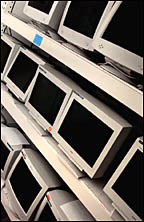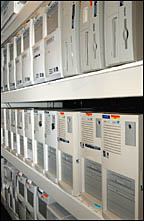|
|
|
|
|
April 16, 2004New plan calls for two-tiered surcharge
A two-tiered surcharge on hazardous materials is under consideration as a way to partially fund a new waste management facility on campus. The proposal makes significant changes to an earlier plan for a flat surcharge on all regulated materials. The new proposal is intended to address a number of concerns raised about the original proposal. Under the plan, departments and units would pay a 5 percent surcharge when they purchase hazardous materials that require the most oversight by environmental health and safety (EH&S). For items requiring less oversight, departments and units would be charged 1.75 percent, said Warren Madden, vice president for business and finance. For example, batteries, cleaning supplies and automotive parts would fall under the 5 percent category, while computer hardware, veterinary supplies and lab equipment would be under the 1.75 percent category. The surcharge is needed to repay $6 million that has been financed through a bond issue for a new waste management facility, to be built on the north side of campus, Madden said. The rest of the $10 million facility cost will come from central funding. The building, which has been approved by the Board of Regents, State of Iowa, will house the environmental health and safety department, which is responsible for dealing with ISU's regulated materials. The original plan, unveiled in January, called for a flat 3 percent charge on all regulated materials. However, some in the campus community voiced concerns over the surcharge, Madden said. Some felt the flat fee was too broad, especially when it included items that do not currently require direct EH&S oversight, like computers, he said. Others thought the surcharge should be limited to items that are managed at the facility. Some researchers said the surcharge should only be applied to future grants so the cost could be worked into the budgets. The new proposal exempts direct purchases by research grants and other sponsored programs made before July 1, 2006. Other researchers also noted the surcharge would be one of several new costs they must add to sponsored funding requests and were concerned about whether they could remain competitive when seeking external funding. Some said they would prefer to pay for the new facility through the indirect cost rate, even if it meant they would pay more, Madden said. Those from self-supporting units, such as the veterinary hospital and transportation services, said the additional cost would make them less competitive with external service providers, he added. Eliminating the surcharge is not an option, Madden said, because the university is bound legally by the bond covenants to create a surcharge that generates at least $610,000 annually. The two-tier structure is expected to generate that amount. The 3 percent surcharge would have paid off the bonds early. Some items that rarely involve environmental health and safety services -- such as disposable laboratory supplies, and farm chemicals and fertilizers used outside the Ames area -- have been removed from the list of items covered by the surcharge. President Gregory Geoffory will gather comment from the Faculty Senate, vice presidents and deans before he makes a final decision on the new plan. |
||||
|
Ames, Iowa 50011, (515) 294-4111 Published by: University Relations, online@iastate.edu Copyright © 1995-2004, Iowa State University. All rights reserved. |

